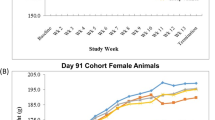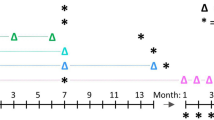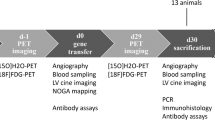Abstract
The promise of gene therapy for health care will not be realized until gene delivery systems are capable of achieving efficient, cell-specific gene delivery in vivo. Here we describe an adenoviral system for achieving cell-specific transgene expression in pulmonary endothelium. The combination of transductional targeting to a pulmonary endothelial marker (angiotensin-converting enzyme, ACE) and an endothelial-specific promoter (for vascular endothelial growth factor receptor type 1, flt-1) resulted in a synergistic, 300,000-fold improvement in the selectivity of transgene expression for lung versus the usual site of vector sequestration, the liver. This combined approach should be useful for the design of other gene delivery systems.
This is a preview of subscription content, access via your institution
Access options
Subscribe to this journal
Receive 12 print issues and online access
$209.00 per year
only $17.42 per issue
Buy this article
- Purchase on Springer Link
- Instant access to full article PDF
Prices may be subject to local taxes which are calculated during checkout





Similar content being viewed by others
References
Lane, K.B. et al. Heterozygous germline mutations in BMPR2, encoding a TGF-beta receptor, cause familial primary pulmonary hypertension. The International PPH Consortium. Nat. Genet. 26, 81–84 (2000).
Deng, Z. et al. Familial primary pulmonary hypertension (gene PPH1) is caused by mutations in the bone morphogenetic protein receptor-II gene. Am. J. Hum. Genet. 67, 737–744 (2000).
Moraes, D. & Loscalzo, J. Pulmonary hypertension: newer concepts in diagnosis and management. Clin. Cardiol. 20, 676–682 (1997).
Russell, W.C. Update on adenovirus and its vectors. J. Gen. Virol. 81, 2573–2604 (2000).
Rodman, D.M. et al. In vivo gene delivery to the pulmonary circulation in rats: transgene distribution and vascular inflammatory response. Am. J. Respir. Cell. Mol. Biol. 16, 640–649 (1997).
Huard, J. et al. The route of administration is a major determinant of the transduction efficiency of rat tissues by adenoviral recombinants. Gene Ther. 2, 107–115 (1995).
Bergelson, J.M. et al. Isolation of a common receptor for Coxsackie B viruses and adenoviruses 2 and 5. Science 275, 1320–1323 (1997).
Tomko, R.P., Xu, R. & Philipson, L. HCAR and MCAR: the human and mouse cellular receptors for subgroup C adenoviruses and group B coxsackieviruses. Proc. Natl. Acad. Sci. USA 94, 3352–3356 (1997).
Yee, D. et al. Adenovirus-mediated gene transfer of herpes simplex virus thymidine kinase in an ascites model of human breast cancer. Hum. Gene Ther. 7, 1251–1257 (1996).
Wickham, T.J. Targeting adenovirus. Gene Ther. 7, 110–114 (2000).
Douglas, J.T. et al. Targeted gene delivery by tropism-modified adenoviral vectors. Nat. Biotechnol. 14, 1574–1578 (1996).
Krasnykh, V.N., Douglas, J.T. & van Beusechem, V.W. Genetic targeting of adenoviral vectors. Mol. Ther. 1, 391–405 (2000).
Reynolds, P.N. et al. A targetable injectable adenoviral vector for selective gene delivery to pulmonary endothelium in vivo. Mol. Ther. 2, 562–578 (2000).
Franke, F.E. et al. CD143 Workshop: angiotensin-I-converting enzyme (CD143) on endothelial cells in normal and in pathological conditions. In Leukocyte typing VI. (eds Kishimoto, T. et al.) 749–751 (Garland Publishing Inc., New York, NY; 1997).
Danilov, S.M. et al. Pulmonary uptake and tissue selectivity of antibodies to surface endothelial antigens: key determinants of vascular immunotargeting. Am. J. Physiol. (Lung Cell. Mol. Physiol.) 280, L1335–L1347 (2001).
Leissner, P. et al. Influence of adenoviral fiber mutations on viral encapsidation, infectivity and in vivo tropism. Gene Ther. 8, 49–57 (2001).
Alemany, R. & Curiel, D.T. CAR binding ablation does not change biodistribution or toxicity of adenoviral vectors. Gene Ther. in press (2001).
Wickham, T.J., Mathias, P., Cheresh, D.A. & Nemerow, G.R. Integrins alpha v beta 3 and alpha v beta 5 promote adenovirus internalization but not virus attachment. Cell 73, 309–319 (1993).
Nettelbeck, D.M., Jerome, V. & Muller, R. Gene therapy: designer promoters for tumour targeting. Trends Genet. 16, 174–181 (2000).
Adachi, Y. et al. Midkine promoter-based adenoviral vector gene delivery for pediatric solid tumors. Cancer Res. 60, 4305–4310 (2000).
Koeneman, K.S. et al. Osteocalcin-directed gene therapy for prostate-cancer bone metastasis. World J. Urol. 18, 102–110 (2000).
Yamamoto, M., Alemany, R., Adachi, Y., Grizzle, W.E. & Curiel, D.T. Characterization of the cyclooxygenase-2 promoter in an adenoviral vector and its application for the mitigation of toxicity in suicide gene therapy of gastrointestinal cancers. Mol. Ther. 3, 385–394. (2001).
Nicklin, S.A. et al. Analysis of cell-specific promoters for viral gene therapy targeted at the vascular endothelium. Hypertension 38, 65–70 (2001).
Bristol, J.A., Shirley, P., Idamakanti, N., Kaleko, M. & Connelly, S. In vivo dose threshold effect of adenovirus-mediated factor VIII gene therapy in hemophiliac mice. Mol. Ther. 2, 223–232 (2000).
Tao, N. et al. Sequestration of adenoviral vector by Kupffer cells leads to a nonlinear dose response of transduction in liver. Mol. Ther. 3, 28–35 (2001).
Reynolds, P.N. et al. Targeting adenoviral infection with basic fibroblast growth factor enhances gene delivery to vascular endothelial and smooth muscle cells. Tumor Targeting 3, 156–168 (1998).
Wickham, T.J. et al. Targeted adenovirus gene transfer to endothelial and smooth muscle cells by using bispecific antibodies. J. Virol. 70, 6831–6838 (1996).
Harari, O.A. et al. Targeting an adenoviral gene vector to cytokine-activated vascular endothelium via E-selectin. Gene Ther. 6, 801–807 (1999).
Nicklin, S.A., White, S.J., Watkins, S.J., Hawkins, R.E. & Baker, A.H. Selective targeting of gene transfer to vascular endothelial cells by use of peptides isolated by phage display. Circulation 102, 231–237 (2000).
Danilov, S.M. et al. Lung is the target organ for a monoclonal antibody to angiotensin- converting enzyme. Lab. Invest. 64, 118–124 (1991).
Danilov, S. et al. Interaction of mAb to angiotensin-converting enzyme (ACE) with antigen in vitro and in vivo: antibody targeting to the lung induces ACE antigenic modulation. Int. Immunol. 6, 1153–1160 (1994).
Ring, C.J., Harris, J.D., Hurst, H.C. & Lemoine, N.R. Suicide gene expression induced in tumour cells transduced with recombinant adenoviral, retroviral and plasmid vectors containing the ERBB2 promoter. Gene Ther. 3, 1094–1103 (1996).
Schuster, D.P., Crouch, E.C., Parks, W.C., Johnson, T. & Botney, M.D. Angiotensin converting enzyme expression in primary pulmonary hypertension. Am. J. Respir. Crit. Care Med. 154, 1087–1091 (1996).
Hirose, S., Hosoda, Y., Furuya, S., Otsuki, T. & Ikeda, E. Expression of vascular endothelial growth factor and its receptors correlates closely with formation of the plexiform lesion in human pulmonary hypertension. Pathol. Int. 50, 472–479 (2000).
Orte, C., Polak, J.M., Haworth, S.G., Yacoub, M.H. & Morrell, N.W. Expression of pulmonary vascular angiotensin-converting enzyme in primary and secondary plexiform pulmonary hypertension. J. Pathol. 192, 379–384. (2000).
He, T.C. et al. A simplified system for generating recombinant adenoviruses. Proc. Natl. Acad. Sci. USA 95, 2509–2514 (1998).
Morishita, K., Johnson, D.E. & Williams, L.T. A novel promoter for vascular endothelial growth factor receptor (flt-1) that confers endothelial-specific gene expression. J. Biol. Chem. 270, 27948–27953 (1995).
Graham, F. & Prevec, L. Manipulation of adenovirus vectors. In Methods in molecular biology 7—gene transfer and expression techniques. (eds Murray, E.J. & Walker, J.M.) 109–129 (Humana Press, Clifton, NJ; 1991).
Raben, D. et al. Enhancement of radiolabeled antibody binding and tumor localization through adenoviral transduction of the human carcinoembryonic antigen gene. Gene Ther. 3, 567–580 (1996).
Conry, R.M. et al. Immune response to a carcinoembryonic antigen polynucleotide vaccine. Cancer Res. 54, 1164–1168 (1994).
Acknowledgements
This research was supported by grants from the American Heart Association, NIH-NIDDK P30 DK54781, and the Avon Products Foundation to P.N.R.; NIH-NCI RO1 CA74242 to D.T.C. and British Heart Foundation (PG97/018 and PG99/097) grants to A.H.B. We would also like to thank Masato Yamamoto for providing the AdCMVLuc virus, and Long Le, Kathee Mercer, and the UAB Image Analysis Core for technical assistance.
Author information
Authors and Affiliations
Corresponding author
Rights and permissions
About this article
Cite this article
Reynolds, P., Nicklin, S., Kaliberova, L. et al. Combined transductional and transcriptional targeting improves the specificity of transgene expression in vivo. Nat Biotechnol 19, 838–842 (2001). https://doi.org/10.1038/nbt0901-838
Received:
Accepted:
Issue Date:
DOI: https://doi.org/10.1038/nbt0901-838
This article is cited by
-
Lipid Nanoparticles for Nucleic Acid Delivery to Endothelial Cells
Pharmaceutical Research (2023)
-
Targeting therapeutics to endothelium: are we there yet?
Drug Delivery and Translational Research (2018)
-
The myeloid-binding peptide adenoviral vector enables multi-organ vascular endothelial gene targeting
Laboratory Investigation (2014)
-
Adeno-associated virus serotype 9 efficiently targets ischemic skeletal muscle following systemic delivery
Gene Therapy (2013)
-
A myeloid cell-binding adenovirus efficiently targets gene transfer to the lung and escapes liver tropism
Gene Therapy (2013)



